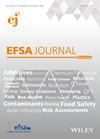对所有动物品种的饲料添加剂盐酸硫胺素(3a820)和单硝酸硫胺素(3a821)(维生素B1)授权更新的评估(Kaesler Nutrition GmbH)
IF 3.3
3区 农林科学
Q2 FOOD SCIENCE & TECHNOLOGY
引用次数: 0
摘要
根据欧盟委员会的要求,欧洲食品安全局被要求就盐酸硫胺素和单硝酸硫胺素(维生素B1)的安全性和有效性发表科学意见,以更新其作为所有动物物种营养饲料添加剂的授权。动物饲料中使用的添加剂和产品或物质小组(FEEDAP)得出结论,单硝酸硫胺素和盐酸硫胺素对所有动物物种、消费者和环境都是安全的。考虑到使用者的安全,这两种硫胺素盐都被认为是皮肤和眼睛的刺激物,以及皮肤和呼吸的致敏物。小组的结论是,在授权续期的背景下,没有必要评估添加剂的功效。本文章由计算机程序翻译,如有差异,请以英文原文为准。
Assessment of the feed additives thiamine hydrochloride (3a820) and thiamine mononitrate (3a821) (vitamin B1) for all animal species for the renewal of their authorisation (Kaesler Nutrition GmbH)
Following a request from the European Commission, EFSA was asked to deliver a scientific opinion on the safety and efficacy of thiamine hydrochloride and thiamine mononitrate (vitamin B1) for the renewal of its authorisation as nutritional feed additives for all animal species. The Panel on Additives and Products or Substances used in Animal Feed (FEEDAP) concluded that thiamine mononitrate and thiamine hydrochloride remain safe for all animal species, consumers and the environment. Regarding the user safety, both thiamine salts are regarded as skin and eye irritants, and skin and respiratory sensitisers. The Panel concluded there is no need for assessing the efficacy of the additives in the context of the renewal of the authorisation.
求助全文
通过发布文献求助,成功后即可免费获取论文全文。
去求助
来源期刊

EFSA Journal
Veterinary-Veterinary (miscellaneous)
CiteScore
5.20
自引率
21.20%
发文量
422
审稿时长
5 weeks
期刊介绍:
The EFSA Journal covers methods of risk assessment, reports on data collected, and risk assessments in the individual areas of plant health, plant protection products and their residues, genetically modified organisms, additives and products or substances used in animal feed, animal health and welfare, biological hazards including BSE/TSE, contaminants in the food chain, food contact materials, enzymes, flavourings and processing aids, food additives and nutrient sources added to food, dietetic products, nutrition and allergies.
 求助内容:
求助内容: 应助结果提醒方式:
应助结果提醒方式:


